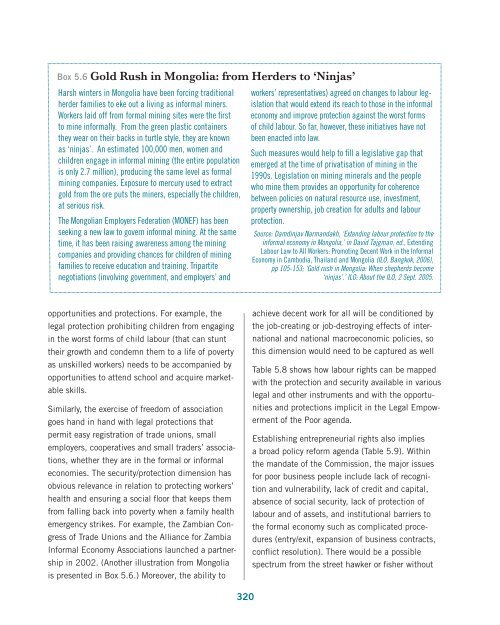Download the file - United Nations Rule of Law
Download the file - United Nations Rule of Law
Download the file - United Nations Rule of Law
You also want an ePaper? Increase the reach of your titles
YUMPU automatically turns print PDFs into web optimized ePapers that Google loves.
Box 5.6 Gold Rush in Mongolia: from Herders to ‘Ninjas’Harsh winters in Mongolia have been forcing traditionalherder families to eke out a living as informal miners.Workers laid <strong>of</strong>f from formal mining sites were <strong>the</strong> firstto mine informally. From <strong>the</strong> green plastic containers<strong>the</strong>y wear on <strong>the</strong>ir backs in turtle style, <strong>the</strong>y are knownas ‘ninjas’. An estimated 100,000 men, women andchildren engage in informal mining (<strong>the</strong> entire populationis only 2.7 million), producing <strong>the</strong> same level as formalmining companies. Exposure to mercury used to extractgold from <strong>the</strong> ore puts <strong>the</strong> miners, especially <strong>the</strong> children,at serious risk.The Mongolian Employers Federation (MONEF) has beenseeking a new law to govern informal mining. At <strong>the</strong> sametime, it has been raising awareness among <strong>the</strong> miningcompanies and providing chances for children <strong>of</strong> miningfamilies to receive education and training. Tripartitenegotiations (involving government, and employers’ andworkers’ representatives) agreed on changes to labour legislationthat would extend its reach to those in <strong>the</strong> informaleconomy and improve protection against <strong>the</strong> worst forms<strong>of</strong> child labour. So far, however, <strong>the</strong>se initiatives have notbeen enacted into law.Such measures would help to fill a legislative gap thatemerged at <strong>the</strong> time <strong>of</strong> privatisation <strong>of</strong> mining in <strong>the</strong>1990s. Legislation on mining minerals and <strong>the</strong> peoplewho mine <strong>the</strong>m provides an opportunity for coherencebetween policies on natural resource use, investment,property ownership, job creation for adults and labourprotection.Source: Damdinjav Narmandakh, ‘Extending labour protection to <strong>the</strong>informal economy in Mongolia,’ in David Tajgman, ed., ExtendingLabour <strong>Law</strong> to All Workers: Promoting Decent Work in <strong>the</strong> InformalEconomy in Cambodia, Thailand and Mongolia (ILO, Bangkok, 2006),pp 105-153; ‘Gold rush in Mongolia: When shepherds become‘ninjas’.’ ILO: About <strong>the</strong> ILO, 2 Sept. 2005.opportunities and protections. For example, <strong>the</strong>legal protection prohibiting children from engagingin <strong>the</strong> worst forms <strong>of</strong> child labour (that can stunt<strong>the</strong>ir growth and condemn <strong>the</strong>m to a life <strong>of</strong> povertyas unskilled workers) needs to be accompanied byopportunities to attend school and acquire marketableskills.Similarly, <strong>the</strong> exercise <strong>of</strong> freedom <strong>of</strong> associationgoes hand in hand with legal protections thatpermit easy registration <strong>of</strong> trade unions, smallemployers, cooperatives and small traders’ associations,whe<strong>the</strong>r <strong>the</strong>y are in <strong>the</strong> formal or informaleconomies. The security/protection dimension hasobvious relevance in relation to protecting workers’health and ensuring a social floor that keeps <strong>the</strong>mfrom falling back into poverty when a family heal<strong>the</strong>mergency strikes. For example, <strong>the</strong> Zambian Congress<strong>of</strong> Trade Unions and <strong>the</strong> Alliance for ZambiaInformal Economy Associations launched a partnershipin 2002. (Ano<strong>the</strong>r illustration from Mongoliais presented in Box 5.6.) Moreover, <strong>the</strong> ability toachieve decent work for all will be conditioned by<strong>the</strong> job-creating or job-destroying effects <strong>of</strong> internationaland national macroeconomic policies, sothis dimension would need to be captured as wellTable 5.8 shows how labour rights can be mappedwith <strong>the</strong> protection and security available in variouslegal and o<strong>the</strong>r instruments and with <strong>the</strong> opportunitiesand protections implicit in <strong>the</strong> Legal Empowerment<strong>of</strong> <strong>the</strong> Poor agenda.Establishing entrepreneurial rights also impliesa broad policy reform agenda (Table 5.9). Within<strong>the</strong> mandate <strong>of</strong> <strong>the</strong> Commission, <strong>the</strong> major issuesfor poor business people include lack <strong>of</strong> recognitionand vulnerability, lack <strong>of</strong> credit and capital,absence <strong>of</strong> social security, lack <strong>of</strong> protection <strong>of</strong>labour and <strong>of</strong> assets, and institutional barriers to<strong>the</strong> formal economy such as complicated procedures(entry/exit, expansion <strong>of</strong> business contracts,conflict resolution). There would be a possiblespectrum from <strong>the</strong> street hawker or fisher without320
















